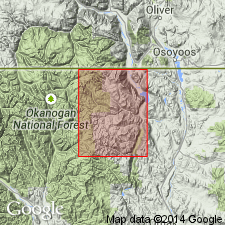
- Usage in publication:
-
- Douglas Mountain Tonalite Porphyry
- Modifications:
-
- Named
- Dominant lithology:
-
- Tonalite
- AAPG geologic province:
-
- Okanogan province
Summary:
Douglas Mountain Tonalite Porphyry. Name proposed for unit in /Toats Coulee magma series [informal] (new). Mapped in Toats Coulee Creek region, Okanogan Range, Washington. Consists of schistose to gneissose rock with relic quartz and plagioclase phenocrysts. Forms small lenses in metasedimentary-metavolcanic rocks. Is important link between Toats Coulee magma series and regional metamorphism. Age is Late Triassic, based on radiometric (K-Ar, hornblende) age of 194 +/-6 Ma of Loomis granodiorite (new) of Toats Coulee magma series (citing Rinehart and Fox [1972]) and stratigraphic relation of Douglas Mountain to Chopaka Intrusive Complex. [Age is Early Jurassic, based on 1983 DNAG Geologic Time Scale and 1986 USGS Geologic Time Chart.]
Type area stated to be on Douglas Mountain, in secs. 8, 9, 16, and 17, T. 37 N., R. 25 E., Okanogan Co., WA. [Named from Douglas Mountain, Okanogan Co., WA].
["Toats Coulee magma series" considered informal. Term "Series" is applied formally only to chronostratigraphic units (ACSN, 1961, 1970; NACSN, 1983, 2005, 2021). US geologic names lexicon (USGS Bull. 1520, p. 87) lists Douglas Mountain Tonalite Porphyry of Toats Coulee Group (explanation not given).]
Source: GNU records (USGS DDS-6; Menlo GNULEX); US geologic names lexicon (USGS Bull. 1520, p. 87).
For more information, please contact Nancy Stamm, Geologic Names Committee Secretary.
Asterisk (*) indicates published by U.S. Geological Survey authors.
"No current usage" (†) implies that a name has been abandoned or has fallen into disuse. Former usage and, if known, replacement name given in parentheses ( ).
Slash (/) indicates name conflicts with nomenclatural guidelines (CSN, 1933; ACSN, 1961, 1970; NACSN, 1983, 2005, 2021). May be explained within brackets ([ ]).

